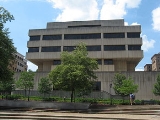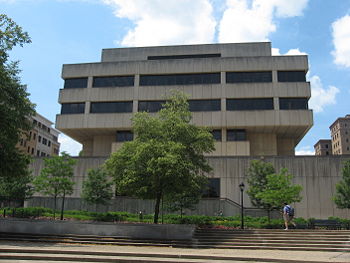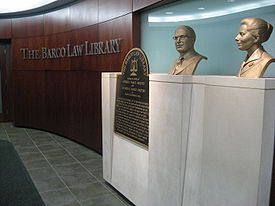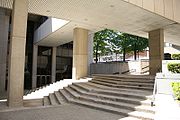
Barco Law Building
Encyclopedia

University of Pittsburgh School of Law
The University of Pittsburgh School of Law was founded in 1895, and became a charter member of the Association of American Law Schools in 1900...
on the campus of the University of Pittsburgh
University of Pittsburgh
The University of Pittsburgh, commonly referred to as Pitt, is a state-related research university located in Pittsburgh, Pennsylvania, United States. Founded as Pittsburgh Academy in 1787 on what was then the American frontier, Pitt is one of the oldest continuously chartered institutions of...
in Pittsburgh
Pittsburgh, Pennsylvania
Pittsburgh is the second-largest city in the US Commonwealth of Pennsylvania and the county seat of Allegheny County. Regionally, it anchors the largest urban area of Appalachia and the Ohio River Valley, and nationally, it is the 22nd-largest urban area in the United States...
, Pennsylvania
Pennsylvania
The Commonwealth of Pennsylvania is a U.S. state that is located in the Northeastern and Mid-Atlantic regions of the United States. The state borders Delaware and Maryland to the south, West Virginia to the southwest, Ohio to the west, New York and Ontario, Canada, to the north, and New Jersey to...
, United States
United States
The United States of America is a federal constitutional republic comprising fifty states and a federal district...
. The $8.5 million six-story building was opened in January 1976 and dedicated on May 1, 1976. The Barco Law Building was designed by the architectural firm of Johnstone, Newcomer and Valentour and is a classic example of brutalist architecture
Brutalist architecture
Brutalist architecture is a style of architecture which flourished from the 1950s to the mid 1970s, spawned from the modernist architectural movement.-The term "brutalism":...
.
History
The University of PittsburghUniversity of Pittsburgh
The University of Pittsburgh, commonly referred to as Pitt, is a state-related research university located in Pittsburgh, Pennsylvania, United States. Founded as Pittsburgh Academy in 1787 on what was then the American frontier, Pitt is one of the oldest continuously chartered institutions of...
has offered law classes since 1843. The School of Law
University of Pittsburgh School of Law
The University of Pittsburgh School of Law was founded in 1895, and became a charter member of the Association of American Law Schools in 1900...
was officially founded in 1895, making it one of the oldest law schools in the nation. In 1900, the law school joined with 31 other schools to form the Association of American Law Schools
Association of American Law Schools
The Association of American Law Schools is a non-profit organization of 170 law schools in the United States. Another 25 schools are "non-member fee paid" schools, which are not members but choose to pay AALS dues. Its purpose is to improve the legal profession through the improvement of legal...
.
Name
On June 19, 2003, Pitt’s School of Law Building was renamed as the Barco Law Building, in memory of George J. Barco and his daughter, Yolanda G. Barco. The Barcos were graduates of Pitt’s School of LawUniversity of Pittsburgh School of Law
The University of Pittsburgh School of Law was founded in 1895, and became a charter member of the Association of American Law Schools in 1900...
and former trustees who were long-standing supporters of the law school, both in life and through their estates. George Barco served as trustee from January 1972 to March 1980, when he was elected as an emeritus trustee. Yolanda Barco served as trustee from February 1990 to June 1997 and was elected an emerita trustee in October 1997.

Barco Law Library
The largest element in the building, the Barco Law Library on floors three, four, and five, serves as the "laboratory" for the work of both students and faculty and is an important information center for practicing lawyers and for scholars from other disciplines. The current collection numbers some 425,000 volumes and volume equivalents and has a seating capacity, in both the individual carrels and in private reading areas, of over 400. The fourth floor is the library's nerve center, containing the circulation desk, the reference desk and reference collection, modern indexing tools, group-study rooms, a microform room, an audiovisual room, and the Harold Obernauer Computerized Legal Research Center. The Obernauer Center, opened in 1987, gives Pitt Law students access to personal computer equipment for research, word processing, and programmed courses of instruction. A permanent endowment helps ensure that the school can maintain the quality of the library and respond fully to the teaching and research missions of the law school, as well as to provide a continuing learning resource for practitioners in the law. Faculty offices ring the perimeter of the library on floors three and five. The library also contains an art gallery with rotating exhibits.Classrooms
The assembly areas are the next largest element of the building. The facilities are all on the first floor with direct circulation to the main entrance. The spatial arrangements make it possible for the four main classrooms, situated on this floor, to fill and discharge without interference with other activities in the school.Teplitz Memorial Moot Courtroom

A focus of visual interest is the large (24 by 36 foot) mosaic mounted on the wall behind the judges' bench. Designed and created by the University's Virgil Cantini
Virgil Cantini
Virgil David Cantini was an enamelist,sculptor and educator. He was well known for innovation with enamel and steel and received both local and national recognition for his work, including honorary awards, competitive prizes and commissions, along with a Guggenheim Fellowship in 1957...
, the mosaic is a dramatic compound of 126 porcelain-on-steel pieces and represents the artist's conception of the harmony of the law and the rich tapestry of the American legal system. The circle symbolizes the "total process of law." The intersection of the red and blue fields at the top symbolize the opposing sides
Adversarial system
The adversarial system is a legal system where two advocates represent their parties' positions before an impartial person or group of people, usually a jury or judge, who attempt to determine the truth of the case...
in a controversy, within the total process of law. The band across the middle of the mural symbolizes a lie detector tape and Morse Code
Morse code
Morse code is a method of transmitting textual information as a series of on-off tones, lights, or clicks that can be directly understood by a skilled listener or observer without special equipment...
message below read "The truth, the whole truth and nothing but the truth."
Lobby


